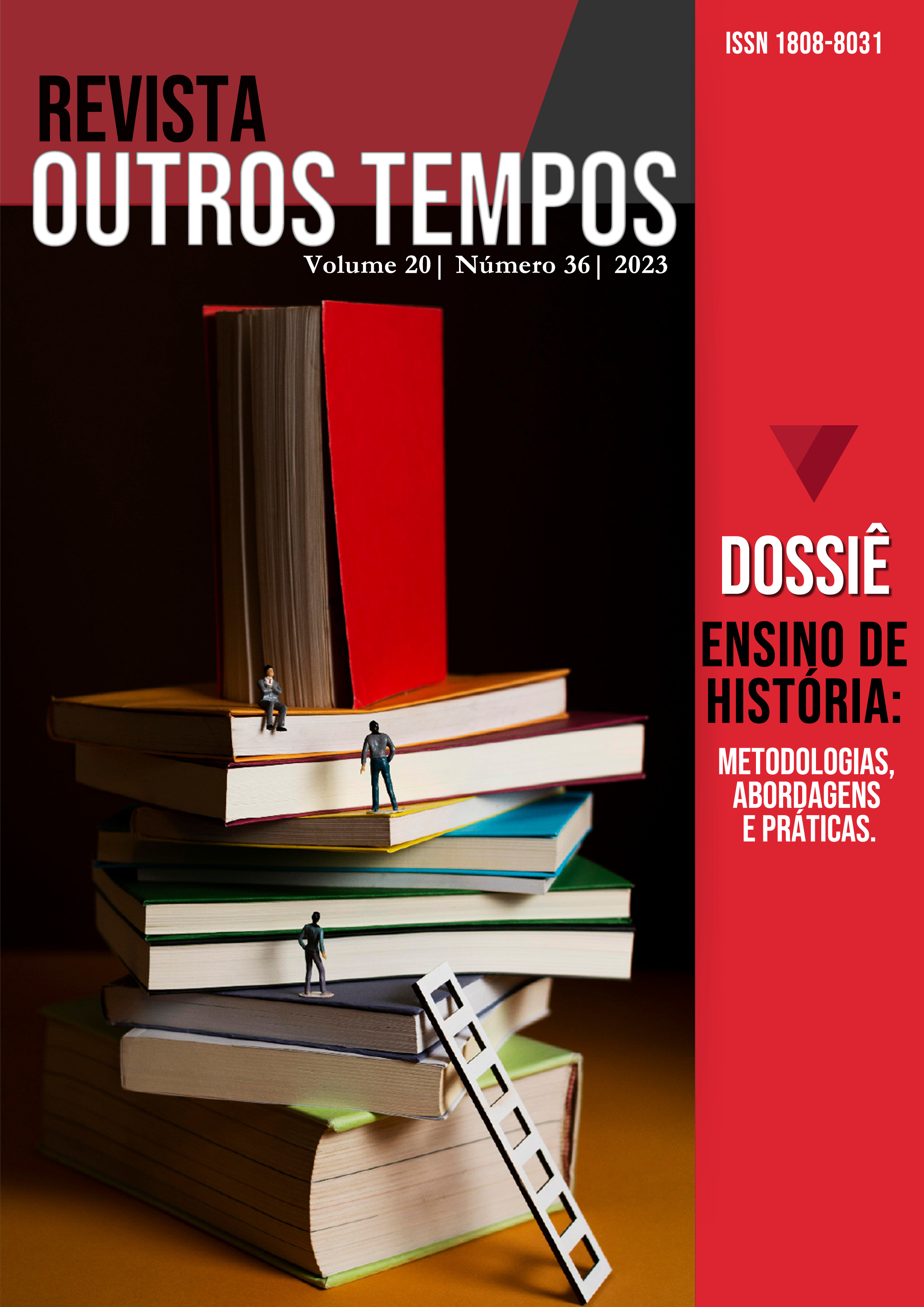CANNON, O ESPIÃO QUE NÃO AMAVA: espionagem e o imaginário masculino da guerra fria (1970-1973)
DOI:
https://doi.org/10.18817/ot.v20i36.1008Palavras-chave:
Guerra Fria., Imaginario Masculino, Histórias em QuadrinhosResumo
O objetivo deste texto é examinar como as tiras de histórias em quadrinhos do superespião estadunidense John Cannon, criadas por Wallace Wood e publicadas entre 1970 e 1973, inserem-se no contexto histórico da Guerra Fria. Presta-se atenção à dimensão anticomunista apresentada nas histórias do personagem e como ela dialoga com formas visuais e esquemas narrativos que se expressam por meio da figura de mulheres, quase sempre objetificadas, desempenhando o papel de femmes fatales. A análise dessa categoria de fonte para a historiografia é reveladora de um imaginário projetado sobre as tensões entre os Estados Unidos e seus inimigos comunistas, bem como nos fornece elementos para interpretar um possível direcionamento dos quadrinhos de Cannon ao gosto de um público masculino.
Downloads
Referências
BACZKO, Bronislaw. Imaginação social. In: ENCICLOPÉDIA Einaudi, volume 5: Anthropos/Homem. Lisboa: Imprensa Nacional: Casa da Moeda, 1985. p. 296-332.
BAKER, Brian. Masculinity in fiction and film: representing men in popular genres 1945-2000. London; New York: Continuum, 2006.
CLUNE, Lori. Executing the Rosenbergs: Death and Diplomacy in a Cold War World. NY: Oxford University Press, 2016.
COSTELLO, Matthew J. Secret Identity Crisis: Comic Books and the Unmasking of Cold War America. New York: Continuum International Publishing Group, 2009.
CROWLEY, David. Posters of the Cold War. London: V & A Publishing, 2008.
EISNER, Will. Narrativas Gráficas. São Paulo: Devir, 2005.
GITLIN, Todd. The Sixties: Years of Hope, Days of Rage. New York: Bantam Books, 1993.
GROENSTEEN, Thierry. Systéme de la bande dessinée. Paris: Presses Universitaries de Frances, 1999.
GROSSMAN, Julie. The femme fatale. New Brunswick; New Jersey: Rutgers University Press, 2020.
HADJU, David. The Ten-Cent Plague: The Great Comic-Book Scare and How It Changed America. New York: Farrar, Straus and Giroux, 2008.
HARDING, Harry. China and the United States: From Hostility to Engagement, 1960-1998. Washington, D.C.: Woodrow Wilson Center Press, 1992.
HERRING, George. America's Longest War: The United States and Vietnam, 1950-1975. 4th ed. New York: McGraw-Hill Education, 2013.
KISSINGER, Henry. Sobre a China. Rio de Janeiro: Objetiva, 2011.
LEE, Peter. Decrypting espionage comic books in 1950s America. In: YORK, Chris; YORK, Rafiel (org.). Comic books and the Cold War, 1946–1962: Essays on graphic treatment of Communism, the code and social concerns. North Carolina: MacFarland & Company, 2012.
LENS, Sidney. A fabricação do império Americano, da revolução ao Vietnã: uma história do imperialismo dos Estados Unidos. Rio de Janeiro: Civilização Brasileira, 2006.
MACARTHUR, Sian. Gender Roles and Political Contexts in Cold War Spy Fiction. Cham, Switzerland: Palgrave Macmillan: Springer Nature, 2022
MACMILLAN, Margaret. Nixon and Mao: The Week That Changed the World. Nova York: Random House, 2008.
MANZANO, Frédéric (ed.); FLÓREZ, Florentino. Woodwork: Wallace Wood 1927-1981. Palma de Mallorca: IDW Publishing & Ajuntament de Palma. 2013.
MUNHOZ, Sidnei. Guerra Fria: história e historiografia. Curitiba: Appris, 2020.
NGUYEN, Lisa (org.). We shot the war: Overseas Weekly in Vietnam. Stanford: Hoover Institute Press, 2018.
OLMSTED, Kathryn S. Blond queens, red spiders, and neurotic old maids: gender and espionage in the early Cold War. Intelligence and National Security, n. 19, v. 1, p. 78-94, 2004. Disponível em: https://kislenko.com/data/wp-content/uploads/2010/01/Olmstead.pdf Acesso em: 20 fev. 2021.
PAYNE, Philip G.; SPAETH, Paul J. Agent of change: the evolution and enculturation of Nick Fury. In: PUSTZ, Matthew (org.). Comic books and the American cultural history. Nova York: Continuum, 2012. p. 184–201.
PEETERS, Benoît. Case, planche, récit: Lire la bande dessinée. Paris: Casterman, 1998.
PRIME, Rebecca. Hollywood Exiles in Europe: The Blacklist and Cold War Film Culture. NY: Rutgers University Press, 2014.
RAMOS, Paulo Eduardo. Tiras no ensino. São Paulo: Parábola Editorial, 2017.
RODRIGUES, Márcio dos Santos. Representações políticas da Guerra Fria: as histórias em quadrinhos de Alan Moore na década de 1980. 2011. 212 f. Dissertação (Mestrado em História) – Faculdade de Filosofia e Ciências Humanas, Departamento de História, Universidade Federal de Minas Gerais, Belo Horizonte, 2011.
SAUNDERS, Frances Stonor. Quem pagou a conta: a CIA na guerra fria da cultura. Rio de Janeiro: Record, 2008.
SBARDELLATI, John; SHAW, Tony. Booting a tramp: Charlie Chaplin, the FBI, and the construction of the subversive image in Red Scare America. Pacific Historical Review, v. 72, n. 4, p. 495-530, 2003. Disponível em: https://history.msu.edu/files/2010/04/Sbardellati-and-Shaw.pdf . Acesso em: 8 fev. 2023.
SBARDELLATI, John. J. Edgar Hoover Goes to the Movies. NY: Cornell University Press, 2012.
SCHULZINGER, Robert D. Kissinger’s China: America’s Changing Role in Asia. Lexington: University Press of Kentucky, 2004.
SHAW, Tony. The politics of Cold War culture. Journal of Cold War Studies, v. 3, n. 3, p. 59-76, 2001.
SOUSANIS, Nick. Unflattening. Cambridge, Massachusetts: Harvard University Press, 2015.
TURNER, Fred. Echoes of Combat: Trauma, Memory, and the Vietnam War. Minneapolis: University of Minnesota Press, 1996.
WITEK, Joseph. Comic books as history: the narrative art of Jack Jackson, Art Spiegelman, and Harvey Pekar. Jackson: University Press of Mississippi, 1989.
WOOD, Wallace. The Complete Cannon. Lake City Way: Fantagraphics Books, 2001.
WOOD, Wallace; SADOWSKI, Greg. Against the Grain: MAD Artist Wallace Wood. Raleigh, North Carolina: TwoMorrows Publishing, 2003.
WOOD, Wallace. Cannon. Lake City Way: Fantagraphics Books, 2014.
Downloads
Publicado
Como Citar
Edição
Seção
Licença

Outros Tempos - Pesquisa em foco - História de http://www.outrostempos.uema.br/site/ é licenciado sob uma Licença Creative Commons Atribuição-NãoComercial-SemDerivados 3.0 Brasil.






